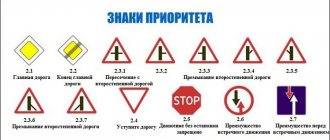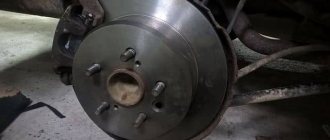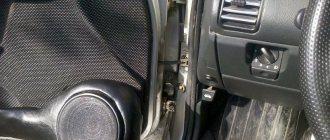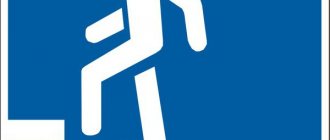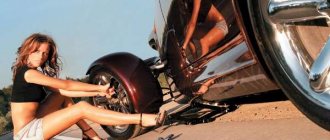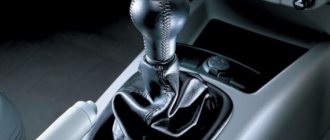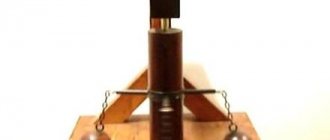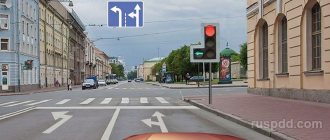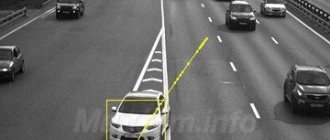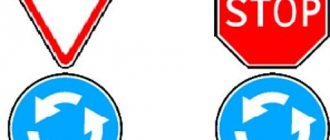One of the grossest violations of traffic rules is considered to be entering a road lane intended for oncoming vehicles. The Administrative Code of the Russian Federation stipulates several situations when a driver may be fined for driving into the oncoming lane. Depending on the type of offense, the amount of monetary punishment for it ranges from one to five thousand rubles . In addition, for the above prohibited maneuver, a motorist may be deprived of his driver's license (DP) for a period of four months to a year . For what specific violations the car owner will be subject to these sanctions and in what form is explained in this article.
What is considered an oncoming trip?
Entering into oncoming traffic is usually understood as driving a vehicle onto a road lane intended for oncoming vehicles. Since the movement of traffic flows on the road is determined by markings, signs and traffic lights, when driving in populated areas and outside the city, drivers are required to follow their instructions. In some cases, markings and traffic signs allow motorists to enter the oncoming lane to perform certain actions on them, in others they are strictly prohibited.
Thus, a person driving a car will not be punished if:
- He makes a left turn (U-turn) at an intersection with a broken marking line separating passing and oncoming traffic flows, under the permitting traffic light signal (if any). In this case, the motorist has the legal right to enter the lane along which vehicles are moving towards him and perform the specified action.
- If a car is driving on a road with a broken line in the middle and there are no prohibiting signs on this section of the road, then the traffic rules allow you to enter the oncoming lane to overtake passing vehicles.
- It is allowed to drive into the oncoming lane when the car is moving on a road with markings 1.11, which is a solid single line along which there is a broken line. However, in this case, crossing such a double line for a turn (turn) is allowed only from the side of its broken component.
If multidirectional traffic flows are separated by continuous markings (and it doesn’t matter: single 1.1 or double 1.3), then crossing such a line and driving into oncoming traffic is already considered a traffic violation, for which, according to the Code of Administrative Offenses of the Russian Federation, strict sanctions follow.
It is important to take into account that even a maneuver in which the vehicle crosses the marking line not completely, but at least partially with two wheels, is considered to be driving into oncoming traffic. In addition, similar prohibited actions include changing lanes to a reverse section of the road when a traffic light is not working or its red signal, as well as driving against the flow of traffic on a one-way street.
We talked in detail about how to appeal a traffic police fine from a camera in this article.
Drifting into the oncoming lane is a serious violation, which is most often punishable by deprivation of rights for a period of 4 to 6 months, or up to 12 months if committed repeatedly within a year. A fine of 5,000 rubles. the case is limited only if the violation is recorded on camera (or in rare cases by a court decision). At the same time, there are many situations when driving into oncoming traffic is classified under other articles or does not imply a violation at all.
When will you be deprived of your rights?
Driving in the oncoming lane, including backwards
In most situations where this is prohibited, driving into oncoming traffic means deprivation of rights, explains car lawyer Sergei Smirnov. This applies to driving in the oncoming lane, overtaking through a solid marking line, entering the tram lane in the opposite direction, as well as driving on a one-way road in the opposite direction. Moreover, driving backwards on a one-way road also qualifies as driving in the oncoming lane with the same consequences.
What to do, if:
Articles June 14, 2020 New instructions: motorists are explained why they will be deprived of their rights
Articles December 12, 2020 They will deprive you of your license without trial: how they will deal with inappropriate drivers
Driving in the oncoming lane
On roads where car traffic is organized in one direction and route transport in the other, the same rules apply. Driving into the lane intended for an oncoming bus means deprivation of your license, and at the same time the driver can be punished for driving in the lane for public transport. But if you drive onto the side of the road for route traffic, but in the same direction, you will not be deprived of your license. This action is equivalent to going to a regular private parking lot with a fine of 1,500 rubles. or 3000 rub. in Moscow and St. Petersburg.
Incorrect turning and turning trajectory
There is a whole set of typical mistakes when a driver can lose his license when turning left. All of them are in one way or another connected with driving into the oncoming lane, and therefore qualify accordingly. The first option is to cut the trajectory, when the car, when turning, gets into the desired lane, having previously caught the oncoming one. The second is turning too early, when the car begins the maneuver while already in oncoming traffic, for example, when passing a car standing at a traffic light. It is also a big mistake to make a U-turn at an intersection through oncoming traffic rather than passing traffic, which also threatens the deprivation of your license.
Overtaking at an intersection
Russian traffic regulations allow overtaking at an intersection only when driving on the main road and provided that markings and signs allow such maneuvers. In all other situations, overtaking is prohibited - this applies to driving both on a secondary road and at an intersection, which is regulated by a traffic light or a traffic police inspector. Overtaking in such a situation is clearly interpreted as prohibited entry into the oncoming lane with subsequent deprivation of rights.
Overtaking and returning through a continuous lane
Legal overtaking, which was completed after the end of the broken marking line, is also interpreted as illegal entry into the oncoming lane. “Many drivers tried to sue, explaining that they drove into oncoming traffic when it was allowed. But the Supreme Court clarified that before overtaking, the driver must make sure that he will have time to complete the maneuver according to the rules,” adds Sergei Smirnov. The lawyer considers this decision logical, since a solid line appears already where being in the oncoming lane is dangerous.
Half a wheel in the oncoming lane
The rules do not regulate what exactly is considered an oncoming drive. “The punishment has been established specifically for the fact of driving off, so formally driving off is considered to be any part of the car entering the oncoming lane, even if it is half a wheel,” explains the lawyer. The idea, Smirnov adds, is that theoretically even half a wheel is enough for a serious accident if the protruding part of the car collides at speed with an oncoming car, which will rightfully be in its own lane.
Car services Autonews No need to search anymore. We guarantee the quality of services. Always near.
Intermittent markings and “No overtaking” sign
Intermittent markings may well be adjacent to a sign prohibiting overtaking, and in this situation entering the oncoming lane is prohibited. However, Sergei Smirnov clarifies that such a combination is rare on the roads: “This happens if a temporary sign prohibiting overtaking is posted, for example, in a repair work zone. And violation in this case, of course, threatens with deprivation of rights.” On the other hand, under the sign of a prohibition on overtaking there may be a sign when the sign begins to operate, the lawyer adds: “Under the sign there is a sign that says that after 500 meters overtaking will be prohibited. But many don’t understand and think that overtaking is prohibited from this point, so they are afraid to go into oncoming traffic.”
Photo: Depositphotos / PhotoXPress.ru
Punishment does not depend on the number of continuous
A more serious punishment for two continuous ones is nothing more than a myth. The law makes no difference between crossing single or double lines. “Single markings are usually drawn where there are only two lanes on the road, and double markings are drawn where there are at least four. It makes no difference whether you entered oncoming traffic through a single or double line - the punishment will be equally severe,” explains Smirnov.
When you won't be deprived of your rights
U-turn and left turn across a continuous road
In addition to the cases listed above with obvious movement in the oncoming lane, the maneuvers of turning and turning across a solid line themselves are milder violations and are not punishable by deprivation of rights. Such maneuvers are described in Part 2 of Art. 12.16 of the Code of Administrative Offenses and are punishable only by a fine of 1000 to 1500 rubles.
U-turn at an intersection with a one-way street
A U-turn at an intersection with a one-way road is not a violation at all, although the driver briefly moves in the opposite direction at the time of the maneuver. Sergei Smirnov believes that this is too loyal an approach: “Logically, this is an equally dangerous violation, because it does not matter whether the car ends up in oncoming traffic and creates a danger there - it just drives, turns or turns around.”
Wrong exit from a gas station or parking lot
Entries to a gas station, store parking lot, or other area that is not part of the road network are often organized according to a one-way traffic pattern: entry on one side, exit on the other. Moreover, both are marked with traffic direction signs and “bricks” on the wrong sides. However, violation of the rules of passage in adjacent territories is classified differently. Even if the driver left the gas station under a prohibitory sign through the entrance, he can only be issued a warning or a fine of 500 rubles. under Part 1 of Art. 12.16 Code of Administrative Offences.
Photo: RBC
Overtaking slow moving vehicles
The rules allow you to overtake slow-moving vehicles that are traveling no faster than 30 km/h in the area covered by the “No Overtaking” sign, and the slow-moving vehicle must be marked with a red triangle with a yellow border. But it is worth keeping in mind that overtaking is allowed if there are intermittent markings or their complete absence. Previously, it was allowed to overtake slow-moving vehicles through a solid line, but since 2020 this is prohibited, notes Sergei Smirnov: “This has always been a very controversial point, but several years ago a clarification was made to the rules: crossing a solid marking line 1.1 is prohibited in all cases.”
Leading instead of overtaking
Modern traffic rules interpret overtaking as a maneuver to get ahead of passing traffic, associated with entering the lane of oncoming traffic. Passing a car without entering oncoming traffic is an advance and is not prohibited by the “Overtaking is prohibited” sign. That is, you can legally get ahead of a slow truck that has pulled to the right or even pulled over to the side of the road. Another thing is that leaving a slow-moving vehicle on the side of the road can result in a fine for driving on the side of the road, but in many places two cars can easily fit within one designated lane.
Photo: spbvoditel.ru
Fines for driving in the opposite direction
Regardless of the violation described in this article, the traffic inspector stopped the motorist, the latter will avoid deprivation of VP and will only get off with the loss of money if he committed such an offense for the first time in the last 12 months.
As of 2020, the traffic rules provide for several situations related to prohibited driving into oncoming traffic. If you get into one of them, the driver will automatically punish himself with a ruble. All these situations are listed in the table below.
| No. | Type of violation | Explanation | Fine, r. (Article - Part of the Code of Administrative Offenses) |
| 1 | Overtaking in the oncoming direction | A prohibited maneuver is considered to be not only complete, but also partial intersection of a vehicle with a continuous marking line separating multidirectional traffic flows. | 5000 (12.15 — 4) |
| 2 | Avoiding obstacles in oncoming traffic | Paragraph 1.2 of the traffic rules states that any stationary object in the traffic lane is considered an obstacle. A traffic jam or a vehicle stopped for inspection by a road inspector is not such a traffic jam. | 1000–1500 (12.15 — 3) |
| 3 | Turning across a solid lane into oncoming traffic | It is prohibited to drive through the continuous single 1.1 and double 1.3 lines, as well as the 1.11 marking on the side of its continuous component. | 5000 (12.15 — 4) |
| 4 | Oncoming traffic on a one-way road | Equates to driving into oncoming traffic. | 5000 (12.16 — 3) |
| 5 | Entering the reverse lane | It is not allowed to drive under a broken traffic light. | 5000 (12.15 — 4) |
| Untimely changing from a reverse lane to yellow or entering it under a red traffic light | 1000 (12.12 — 1) | ||
| Avoiding an obstacle in a lane operating in reverse mode | 1000–1500 (12.15 — 3) | ||
| 6 | Traveling onto oncoming tram tracks | When overtaking is equivalent to driving into oncoming traffic. | 5000 (12.15 — 4) |
| If you go around an obstacle, the penalty is mitigated. | 1000–1500 (12.15 — 3) |
Getting a car into oncoming traffic
There are many situations that meet this definition, let’s consider the main cases:
- crossing a lane during various maneuvers on the road;
- simultaneous movement in your own and oncoming lanes;
- driving along the marking line;
- crossing the marking line when maneuvering only with the rear wheel;
- crossing through oncoming traffic when exiting intersecting roads.
Determining the traffic lane is just as important as the oncoming lane. In the traffic rules it is described as any of the longitudinal lanes, whether marked or not, with a width sufficient for the passage of vehicles in one row.
Getting into the oncoming flow of traffic is the actual location of the transport on it to continue forward movement further. Often a car ends up in oncoming traffic when performing a maneuver, but by definition there is no exit as such. The car crosses the markings, but since the lane is not used for movement, it cannot be called an exit.
Crossing oncoming traffic while making a maneuver
The action is performed in a situation where a turn is made with the intersection of a double solid line or a turn in similar conditions. The number of solid lines is not particularly important, since when they separate traffic flows, each of them is not allowed to cross. In this situation, a maneuver occurs with a violation of the markings.
Driving in your own and oncoming lanes at the same time
The situation involves using the oncoming lane for partial movement along it, thus driving towards oncoming traffic, while there is a violation of the rules of markings on the road. Article 12.15 in part four provides for confiscation of rights.
Vehicle movement along the marking line
Only the road patrol can determine if you are entering oncoming traffic. But driving directly along the marking strip itself is not considered to be entering oncoming traffic, since you need to actually cross it. Driving along the markings is a violation of paragraph 9.7 of the traffic rules , for which a fine is provided for under article 12.15 in the first part.
Crossing the marking line with the rear wheel when performing a maneuver
The situation is completely similar to the previous one, since crossing solid markings on the road is prohibited in any case. Responsibility arises under Article 12.16 of the Traffic Regulations in part two and provides for a fine of 1 thousand - 1 thousand 500 rubles.
Moving into the oncoming lane from intersecting roads through continuous markings
This is a complex and ambiguous case, described in Article 8.6 of the Traffic Rules:
- the turn is made in such a way that when leaving the intersecting road there is no exit into the lane of oncoming traffic;
- The right turn is made closer to the right side of the road.
Entering the lane of oncoming traffic due to a turn violates Article 8.6 of the Traffic Regulations, although the car does not intend to move towards oncoming traffic, but it should not appear on the oncoming road on which the turn is being made. The violation is qualified under Article 12.15, part four.
There is no entry into oncoming traffic if the car turns into the oncoming lane while crossing oncoming traffic. Despite the fact that part of the car ends up in the lane of oncoming traffic, it does not move into it. But maneuvers not according to the rules remain , but cannot be punished under the article on the location of vehicles on the road.
Penalty for recording with a camera
Not only a traffic police officer or a judge can fine a violator for driving in the oncoming lane. If the prohibited maneuver is removed by the road system for automatically recording violations, the owner of the vehicle will receive a “chain letter” by mail with a requirement to pay a fine. The only consolation for the violator in this situation is that no matter how many times during the year the traffic cameras “catch” him for such prohibited actions, he will only face the loss of money, but not the deprivation of his license for oncoming traffic.
Lawyers strongly discourage motorists from collecting several similar fines from cameras. The reason for this recommendation is that if in the future a person is stopped by a traffic inspector for any traffic violation that entails the confiscation of a driver’s license, then with almost one hundred percent probability he will not be able to drive a car for the next few months.
For more information about turning left from tram tracks, please follow the link.
Penalties for driving towards traffic
The punishment is regulated by Article 12.15 in the second part:
- driving into oncoming traffic along which a tram should move or creating obstacles to its movement is punishable by a fine of 1 thousand rubles. up to 1 thousand 500 rub. (depending on the wishes of the traffic police inspector);
- avoiding an obstacle along a tram track with oncoming traffic is punishable by a fine of the same size;
- making a U-turn or turning left while crossing a solid lane with a prohibitory sign will result in a fine of 1 thousand rubles. up to 1 thousand 500 rub.
Responsibility for repeat offense
If a motorist commits the same violation related to driving into oncoming traffic a second time within one year and is stopped for this by traffic police officers, he will not get away with the loss of a certain amount or deprivation of his rights for driving into the oncoming lane for a period of 4-6 months. it will work out. In this case, in court he is guaranteed to become a pedestrian for 1 year.
The Code of Administrative Offenses provides for similar severe sanctions for most of the offenses described in the table of fines above. The only exceptions are driving around an obstacle in oncoming traffic (for this and in the event of a repeated violation, the motorist will only get off with a monetary penalty), as well as entering the reverse lane under a prohibiting traffic light.
For the last repeated offense, the owner of the car will face a fine of 5,000 rubles or deprivation of driving license for 4–6 months (Part 3 of Article 12.12 of the Administrative Code).
Extreme necessity - what are we talking about?
The term “extreme necessity” appears in Article 2 of the Administrative Code of the Russian Federation. This article actually gives drivers the opportunity to exercise the right to freedom of movement guaranteed by the Constitution. What is it about?
An extreme necessity when entering the oncoming lane arises, for example, if the main lane is clogged with a broken down bus - in such a situation, the driver has no choice but to make a detour through the solid one. The paradox is that if the motorist stops and waits for the bus to continue moving, he will again become a violator. In fact, he impedes the freedom of movement of other citizens: those who gradually begin to form a “traffic jam” behind him.
If you believe the explanations of the traffic police about driving into the oncoming lane, the driver has the right to cause harm to the state through illegal actions if the damage caused is less than what was prevented. Thanks to this postulate of the Code of Administrative Offenses, motorists can actually break the law without fear of remorse.
Although there are many ways to get away with driving into oncoming traffic, you shouldn’t tempt fate. The consequences of a violation are more serious than a fine - the violator endangers the lives and health of people.
For what actions will you definitely be deprived of your rights?
For almost all types of prohibited movements against the flow, the violator can be punished in different ways: either with a monetary fine or with deprivation of VP. Moreover, the owner of a vehicle may be left without a license not even for repeated entry into oncoming traffic within one year, but for the very first such “crime” in his life. Aggravating circumstances for which the driver will be confiscated to the maximum (for six months for the first offense and for a year for a repeat offense) are:
- Gross disobedience to the demands of traffic police officers to stop while committing prohibited actions (when a motorist refuses to leave the road and continues to move against the flow).
- The owner of the car has several unpaid administrative fines for violating other articles of traffic rules committed by him during the last 12 months.
- Traffic accident as a result of prohibited driving.
- The offender's open disrespect for the court and his attempts to justify himself at all costs, despite the presence of documented evidence of his guilt on the part of road inspectors.
Read more about fines without category E at the link.
In what cases can punishment be avoided?
Despite the fact that driving into oncoming traffic is considered a serious offense, for which it is strictly punished by a fine or deprivation of driving license, even for it you can completely avoid punishment. However, to do this, a person must present convincing arguments, after considering which the inspector who stopped him (or later the judge) will “forgive” him for leaving the oncoming lane. These arguments include:
- Trying to avoid an accident. If a motorist drove across a solid line so as not to crash into another car or hit a person who jumped under the wheels, then most likely he will not be punished.
- An urgent need. It usually means a situation where a motorist entered an oncoming traffic lane while avoiding an obstacle because he could not wait for passing lanes to become free. If the driver provides evidence to the inspector who stopped him that he is taking a seriously ill relative to the hospital or is in a hurry somewhere on an urgent matter, then, most likely, the traffic police officer will not draw up a report on him for driving in the lane for oncoming traffic.
- Unreadable markings or lack of intent on the part of the violator to commit a prohibited maneuver. These are the most controversial arguments that do not work on most inspectors. To prove that the person driving the vehicle drove against the flow of traffic because he did not see the solid prohibiting sign, most often it is necessary to go to court. However, in the case where the car owner faces not a fine, but the confiscation of the driving license, these arguments remain the last chance for the motorist not to turn into a pedestrian for several months.
Similar offenses
Entering the oncoming lane is prohibited
Articles regulating current penalties for overtaking vehicles in front in the oncoming lane appeared in the Code of Administrative Offenses relatively recently - only in 2007. In this regard, cases of drivers being fined for this offense have become noticeably more frequent.
At first glance, this situation cannot but rejoice. After all, by committing such an offense, a motorist not only endangers his own life and health, but also risks the well-being of those who are currently driving in their lane and do not violate traffic rules.
However, as practice shows, most of the fines for driving in oncoming traffic are issued by unscrupulous traffic police inspectors in the absence of a real offense to those drivers who are simply poorly versed in existing legal norms.
How can you avoid becoming a victim of an enterprising traffic inspector? First of all, figure out which, albeit similar, offenses do not belong to the section of the Code of Administrative Offenses described in this article:
- Traveling under a prohibiting entry sign. If the driver inadvertently ignored the mentioned sign “climbed” onto a road with one-way oncoming traffic, he has the right to immediately make a reverse turn. In this case, his actions will fall under the regulations described in Article 12.16 of the Administrative Code, and the penalty imposed for this offense will be limited to a fine of 500 rubles. And this is perhaps the most “painless” way out of this situation for the motorist. After all, by continuing his journey in the given direction, he will violate another article of the traffic rules - “Driving in the lane of oncoming traffic.” And such an offense is punished even more severely. Such a driver will not only be required to pay a fine of 5 thousand rubles, but will also most likely be deprived of the right to drive a vehicle for a period of 4 to 6 months.
- Driving into the oncoming lane to avoid a collision with a car moving “head-on”, that is, in a lane that is foreign to it. Although, technically, the driver who committed such an act is still an offender (which the traffic police will not fail to remind him of), the circumstances under which the incident occurred can help the unlucky motorist avoid administrative liability and not be subject to penalties.
How to appeal a punishment
There are situations when it is almost impossible to appeal a traffic police officer’s decision to impose a monetary penalty on the driver. For example, if a person was stopped for driving oncoming traffic on a one-way street, then the judge is unlikely to believe that the motorist simply did not see the prohibitory sign when entering and drove under the “brick” by accident. The argument that the markings are unreadable even on a snow-covered road will not work if the offender is caught driving on oncoming tram tracks. And so the question arises: is it possible to travel on tram tracks?
Sometimes a driver has a good chance of challenging the traffic inspector’s decision to impose a fine on him. To do this, he should behave confidently and insist that his actions were dictated by extreme necessity (or other reasons that excuse him: an attempt to avoid an accident, unreadable markings, lack of intent to commit an offense or its insignificance).
If all of the above arguments do not work on the inspector and the matter moves towards drawing up a protocol and further transfer of materials about the offense to the analysis group at the traffic police, then the vehicle owner is recommended to:
- Independently record on the spot all the circumstances of the offense charged to him. You need to photograph the road with all the signs and markings on it, and do it in such a way that the traffic police car and the offender’s vehicle are included in the frame along with them.
- If possible, try to find witnesses who could confirm that the prohibited maneuver charged to the driver was performed by him without driving into oncoming traffic.
- Do not agree to the minimum fine proposed by the inspector on the spot, since in the future such an action by the motorist will not allow him to challenge the punishment in court.
- If in the analysis group the case turns not in favor of the offender, then you should not be afraid to go to court. At the same time, in the latter case, it is necessary to behave as respectfully as possible towards the judge: admit that part of the charges that have been proven by the traffic police officers, but at the same time insist on the presence of mitigating circumstances and present your own evidence of your innocence collected at the scene of the offense.
- It must also be remembered that the law gives only 10 days to appeal the decision to impose a fine on the driver. If you miss this deadline, you will no longer be able to avoid monetary punishment.
Oncoming traffic lane
Before considering cases of driving into oncoming traffic, it is necessary to define driving into the oncoming lane. This issue is regulated by the Traffic Rules, approved by Decree of the Government of the Russian Federation of October 23, 1993 N 1090 “On Traffic Rules”. Clause 1.2 of the Rules is devoted to defining the meaning of terms and concepts that appear in the text and must be understood unambiguously by everyone in order to prevent deviations from their original meaning.
This paragraph states that a traffic lane is any of the longitudinal stripes of the roadway, marked or not marked with markings and having a width sufficient for the movement of cars in one row.
The Rules do not contain an unambiguous answer to the question of what is considered driving into the oncoming lane, but this is not difficult to establish from the general meaning of the Rules. We have found out what a “traffic lane” is, now from a linguistic point of view it is not difficult to establish that the oncoming traffic lane is a lane along which traffic is carried out “toward”.
Also, clause 1.4 of the Rules can be involved in resolving this issue, which states that traffic in the Russian Federation is carried out on the right side.
Summarize. The law does not contain an official definition of what is considered driving into oncoming traffic, but it does contain definition criteria. Based on them, we can formulate a definition: oncoming traffic lane - a traffic lane, with or without markings, located to the left of all lanes in the same direction, movement along which is carried out in the direction opposite to the direction of movement of the driver.
Important! Please note that from the definition of a traffic lane, it follows that the absence of markings does not make the roadway one-lane . Some unscrupulous drivers think that if there are no markings, you can drive on such a road as you please. In practice, it turns out that driving into oncoming traffic will be considered to have occurred, even if the road is not visually divided into lanes. In the everyday lexicon you can often find the phrase “cross a solid line” in the sense of entering the lane of oncoming traffic, but if you look into it, it turns out that this is not always the same thing.>
The Rules state that in the absence of markings, the driver must determine the lanes independently. Two factors must be taken into account: the width of the road and the overall dimensions of the car. How many cars can fit on the road at the same time, there are so many lanes on it. The only strict rule in this matter is the evenness of the number of stripes .
This means that if the width of the roadway simultaneously accommodates 3 cars, then there will be only two lanes; if there are 5 cars, then 4. In the absence of markings, it is assumed that each of the directions of traffic, opposite to each other, should have an equal number of lanes with the other direction for movement.
Traffic rules establish that the side of oncoming traffic in the absence of markings will be half the width of the road, located on the left side. Analyzing these provisions, we understand that the side of the oncoming movement is established not only on formal grounds, but also on the basis of substantive criteria.
This means that we will consider the oncoming lane to be that part of the road where traffic is moving towards us.
